
Introduction
Roy's Note: The Madeira Wine Guide was a site created by Dr. Wolf Peter Reutter, and was an in-depth, almost encyclopedic look at Madeira wine. When he decided that he could no longer maintain the site, he graciously offered to allow For The Love Of Port to move his content over to our site so that it could be maintained, updated and so the passionate work he had done would live on for the benefit of others. The first release of this guide is being ported over to this site as it was originally written, but we will begin to add, update and revise content as the trade evolves.
For every wine enthusiast there comes a time when he or she comes across the so-called fortified wines. Those wines are Port, Sherry, Madeira, Malaga, Marsala, and others. Many of those wines are nowadays out of fashion since they are regarded as too heavy, or too sweet. But the fascination still remains for some people...
The first time I came across Madeira wine was when I visited the island in 1995. I became "hooked" immediately and more visits followed. My interest in Madeira wine grew, but at that time, there was little information available. So I wrote up my own "book" and added more - every time I found another piece of information. And that is the story of this little collection of facts about Madeira wine. There is no commercial interest in this whatsoever, but I request the copyright for these pages. Any citation or reproduction by whatever means requires the written consent of the author.
All those who are really interested in getting into detail about Madeira are advised to read the excellent book by Alex Liddell. More information is available in the bibliography section.
Enjoy!
Dr. Wolf Peter Reutter
Roy Hersh on Madeira
In addition to the content in this Madeira Wine Guide, Roy has written many articles on Madeira, which can be accessed via the links below.
- Sensational Sercial
- Velhissimo Verdelho
- Transcendental Terrantez
- The Beauty of Boal
- The Dueling Bastardo vs. Moscatel
- Majesty of Malvasia
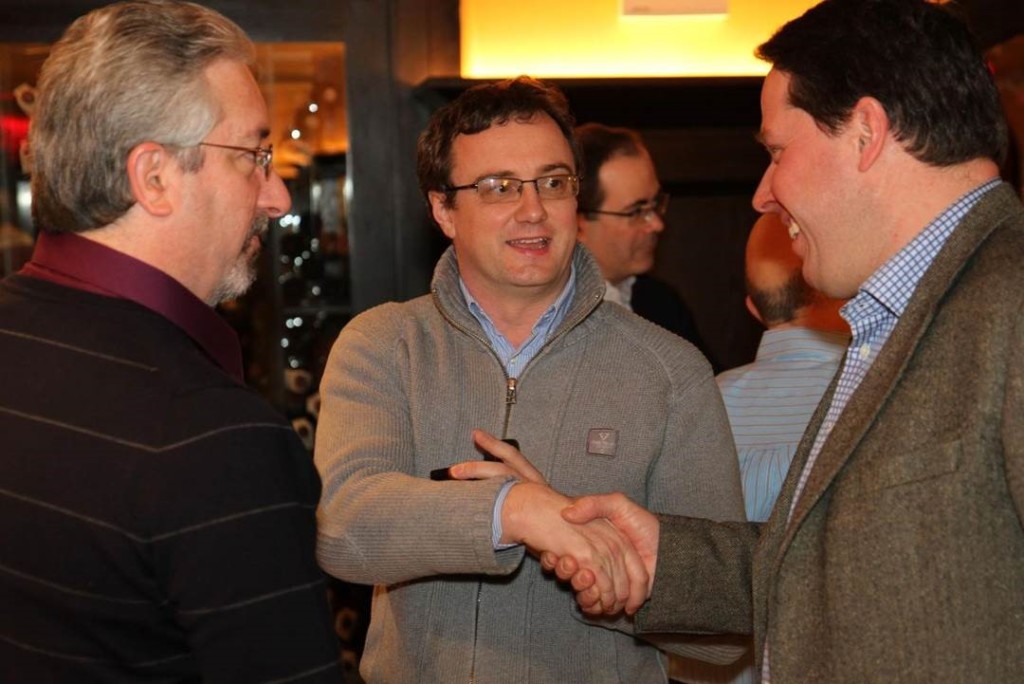
Left to right: Roy Hersh, Neil Martin, and Peter Reutter in NYC (2012) for Transcendental Terrantez
Madeira Geography and Society
Madeira is an archipelago in the Atlantic Ocean, about 1100km southwest of Portugal and 500km west of the North African town of Casablanca. Its exact nautical position is 32°45' north and 17°00' west. The archipelago consists of the inhabited islands Madeira, with the capital Funchal, and Porto Santo. The uninhabited Ilhas Desertas and Ilhas Selvagens also belong to the archipelago that is a total of 800 square kilometers. The island of Madeira is 55km long and 22km wide stretched in a west-east direction and resembles the peak of a 4000m high underwater volcano. The highest point of the mountainous main-island is Pico Ruivo, 1861m. The climate is very moderate; the main wind direction is from northeast featuring the trade winds for about 10 months of the year. The yearly average temperature lies between 16 and 22°C in Funchal. Main rainfall is in autumn and spring. Geologically Madeira consists of basalt and tufa, which are also the main ingredients in the volcanic soil of the vineyards. Madeira means wood in Portuguese and the island has been named so because of its many trees. The population of the archipelago was 275,000 in the mid 90’s, 270.000 living on the main island and 5000 on Porto Santo. Many young inhabitants of Madeira emigrate from the island, but most of these come back to spend their old age in the warm climate. Madeira is an autonomous region of Portugal with its own legislature. Besides Portuguese, English is spoken and understood by many inhabitants because of the British past. Since the declaration of the new constitution in 1976, the government most of the time has been run by the Socialdemocratic party.
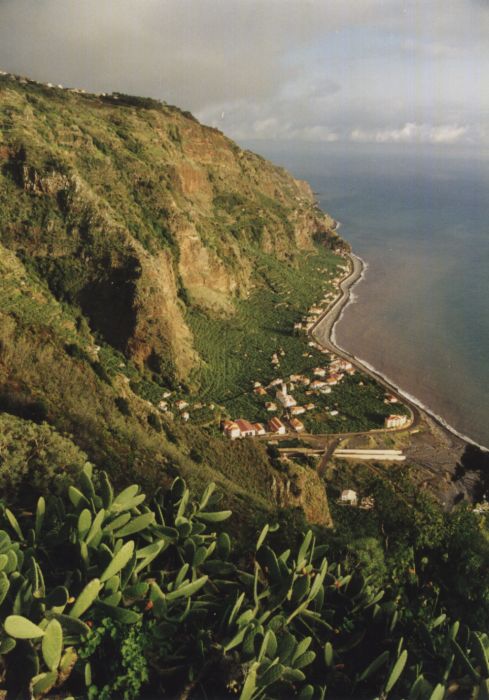
Magdalena Do Mar
The economy of Madeira is based on agriculture, wine, fishing, and tourism. Tourism has become more important over the last few years. Because of the growing number of visitors some traditional industries like wickerwork and embroidery employ more workers. With the help of funds from the European community, the infrastructure is being improved. This includes highways, especially the Via Rapida along the south side of the island, and the expansion of the island's airport at Santa Cruz with its new runway standing on 173 huge concrete poles. Even though the island has quite a remote location, Madeira is very present on the Internet, offering lots of information for tourists and wine-enthusiasts. At the EXPO 2000 in Hanover, Germany, Madeira was one of the featured examples for a modern Internet-based community network.
Madeira History
The official history of Madeira starts with the discovery of the island of Porto Santo by João Gonçalves, also called O Zarco "the cross-eyed" and his fellow officers Bartolomeu Perestrelo and Tristão Vaz Teixeira in 1418. The next year they discovered Madeira island which was just 38 kilometers (23 miles) away. Some people say that the history of Madeira started much earlier. They believe, although there is no archeological proof, that it was the remains of the lost Atlantis. It seems that the Phoenicians knew about the island, but whatever their knowledge was, it has been lost over time. The Arab sailors of Morocco also seem to have had knowledge of an island in the west and called it "El Aghnam". In the 14th century Madeira island has been shown on numerous maps. It can be found under the italic name "Isola de Lolegnane" meaning "island of wood" which is just the same as island of Madeira in Portuguese on the Medici map of 1351. At least four other maps exist from the 14th century where Madeira island is also shown.
Whoever knew of this island, he did not settle there. In the 15th century it was Henry the Navigator who promoted settlement on the island. The first to come were prisoners, but soon there was an established society on Madeira. Something the first settlers brought along was grapevines. Land for the growing of wine was always rare and had to be cultivated with great efforts. This was only possible with the help of slaves, mostly Guanches. They also built the irrigation-system, the levadas. This irrigation enabled the growing of sugarcane which later brought great wealth to the island. Legend tells that O Zarco had set the heavily wooded island on fire which was then ablaze for a period of 7 years. Maybe that contributed to the high fertility of the island. Anyway, the warm climate and the volcanic soil allowed a very efficient cultivation of the land. So of course the grapevines did very well and the first reference to wine grown on the island had been written as early as 1485, only some 60 years after the colonization started. This wine of Madeira was not fortified at first. It was just plain ordinary dry wine, completely fermented. But according to the quotes of Aviso da Mosto, who visited the island in 1453 "Really good wines are produced here..."
In 1508 Funchal was granted the rights of a city and the building of a cathedral (the Se) was initiated by king Manoel. The sugarcane growing became less profitable and so in the first half of the 16th century most of the sugarcane plantings were converted to vineyards. The export of wine began to increase and the middle of the century saw a solid export of wine to the West Indies, America and England. Even the Spanish usurpation of 1580 did not seriously affect the steady growth of export numbers. In 1662 the negotiations for the marriage between Charles II of England and Catharina of Braganca considerably left out Madeira island because it had become one of the most prized possessions of Portugal. Charles II accepted, even without getting the island of Madeira. The bonding between England and Portugal brought the English merchants to the island. The exports steadily expanded and were further augmented by two decrees. In 1643 João IV ordered all ships bound for Brazil to stop at Madeira island for wines. In 1665 Charles II prohibited the shipping of European goods to the West Indies and America unless these goods were being shipped with British ships and from British ports. Madeira had been intentionally left out of this decree, because it meant more tax income for the king.
And so, the new American colonies became a favorite trading partner for this wine. Five years before the Boston tea party there was an open conflict when the sloop "Liberty", smuggling Madeira wine for John Hancock had been seized by the British warship "Romney". In fact John Rowe, owner of the tea that was thrown into Boston harbor in 1773, had a lot of trade going on with the island of Madeira. General Washington was a great friend of this wine; it is said that he drank a pint of it daily. His inauguration as president of the United States and the appointment of the city of Washington as the capital were celebrated with Madeira. So, it’s no surprise that the Americans celebrated their Declaration of Independence with a glass of Madeira. The legendary frigate Constitution, the oldest ship in the world that is still afloat, was also baptized with Madeira wine. Together with its special sandwich live oak planking construction this Madeira wine treatment might have contributed to the invulnerability of "Old Ironsides"... As a remembrance of this event, the Madeira vintage of 1802 has been named Constitution as well. While the European market remained unstable, the US remained a solid importer of Madeira wines. Until the twentieth century Madeira played an important part in the social life of the upper class. It was especially favored in cities such as Baltimore, Boston, Charleston, Philadelphia, New York and Savannah where they celebrated with so-called ‘Madeira-parties’. At these events, you drank several vintages of Madeira to a light meal like terrapin-soup. In Silas Weir Mitchell’s famous book "A Madeira Party" the reader will find a very detailed and slightly ironic picture of such an event. Visitors of Savannah today can do a "Madeira Tour" at the Davenport House and there still is a "Madeira Club" in Savannah.
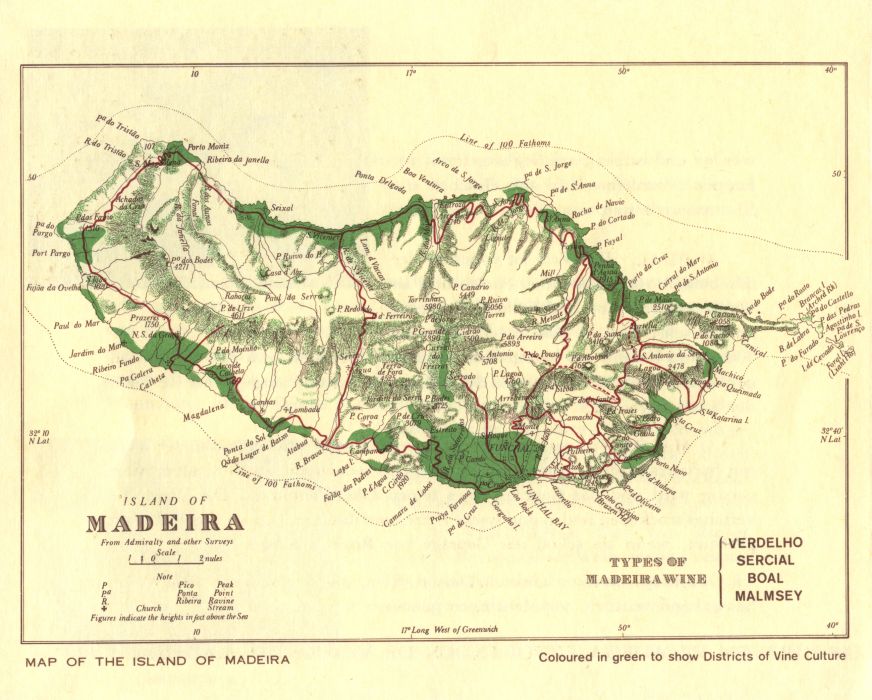
It was just by chance that the positive effect of the long voyage from Madeira to America was discovered. The travel and the heat had turned the wine into something completely different. The baked oxidized taste was to the like of a growing number of people. In the middle of the 18th century fortification began, due to overflowing stocks of wine during times of war. This ‘overflow’ wine was distilled and the resulting alcohol added to the Madeira wine. This procedure also enhanced the durability of the resulting wine. Later the estufagem, the heating of the wine, was invented as a substitute for the long and costly sea travels. The beginning of the 19th century saw most companies treating their wines with the estufagem process. From that point on, it was possible to produce Madeira in greater amounts for the growing market. The fortified wine became more and more en vogue. Many more merchants came to the island of Madeira and entered the wine trade. In the first half of the 19th century, the trade with Madeira wine reached its peak.
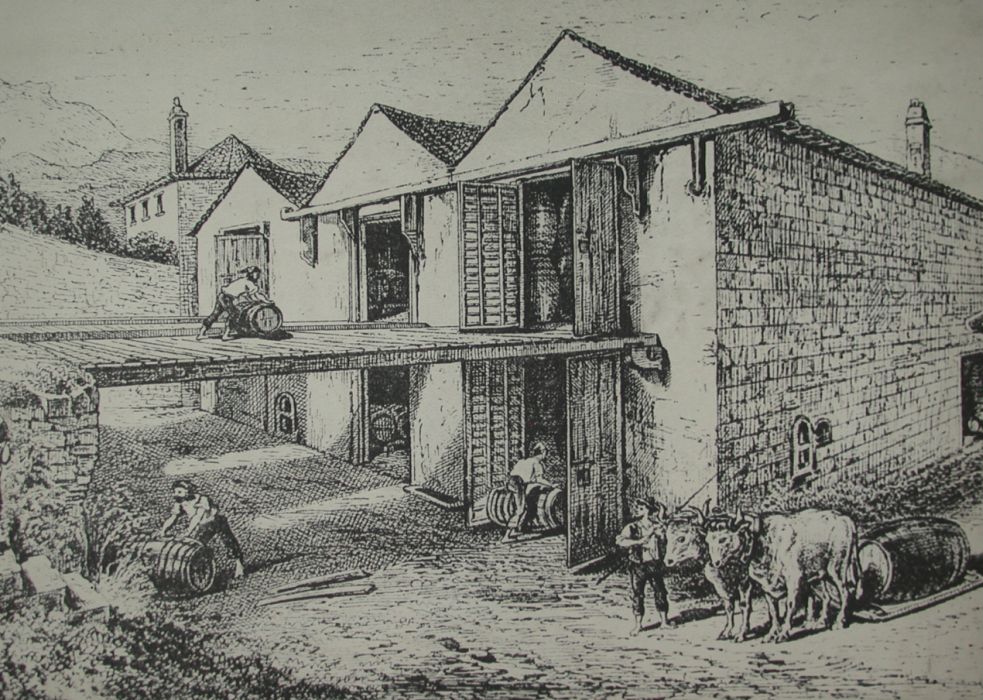
Historic picture of an early estufa of Cossart Gordon, seen at the IVM
And then, within twenty years, two dramatic events hit the island and destroyed the whole wine production. At first Oidium infected the vines in 1851. Before the wine industry had recovered, the second plague Phylloxera hit the island in 1872. Only because of the foresight of some of the shippers did the wine industry survive. In the vineyards the European vines were grafted on Phylloxera-resistent American roots. Oidium was battled with sulfur and copper nitrate. Many old vintages were still in cask and only because of those huge amounts of old pre-Phylloxera wine could they enhance the quality of the later vintages by blending in the old vintages. Still, the quality went down over the following years. Many of the American vines, originally intended for grafting, began to grow free in the vineyards. The versatile Tinta Negra Mole was now being preferred to the difficult classical varieties. With the sinking quality and the increasing competition from other fortified wines the markets dwindled. Madeira wine was no longer used for drinking only but found its way into the cooking pot, usually as an ingredient for sauces.
In 1913 most of the remaining shippers founded the Madeira Wine Association to fight the decline together. All the British shippers and most of the Portuguese shippers eventually entered this association. Today only six exporting producers are left on the island.
But only after 1970 did quality take an upturn. To meet the standards of the European Community Portugal issued guidelines concerning the winemaking. In 1980, the Instituto do Vinho da Madeira (IVM) was founded which supervised the whole wine industry on Madeira from growing the wine to filling the bottles. All bottles therefore bear the "Selo de Garantia Madeira", which guarantees a minimum standard. The replanting of the classical grape varieties is also promoted and lower quality vines are cleared. Still, one has to remember that all those measures will take a long time to work. Because of the long production process, it will take at least a few decades to reach the old quality standard.
The export of bulk wine, a long standing problem for the quality standard, was finally ended in 2001. Since this date only island bottled Madeira wine is available. A little bulk wine is still exported, but this wine is mixed with salt and pepper, so that it can not be rebottled as cheap Madeira wine. The salt and pepper wine can only be used for Madeira wine sauce.
The European Community also wanted to improve the quality of Madeira wine and launched the POSEIMA initiative. Producers who mature wine in the traditional canteiro method (see making of) are financially supported with grants from EU. The wine has to stay in cask for a minimum time of 5 years.
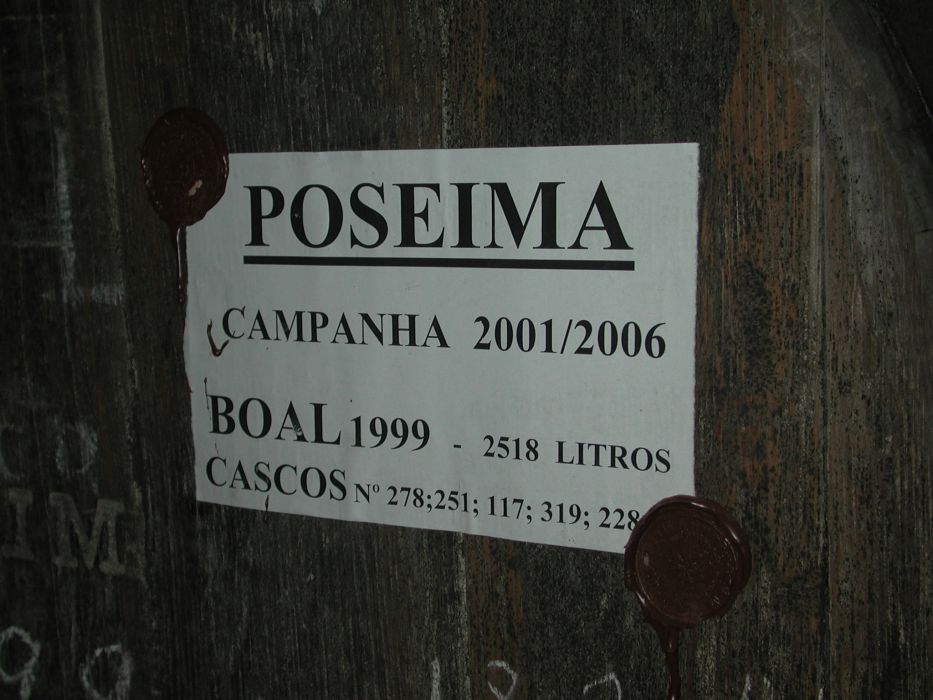
POSEIMA wine at ABSL
Nevertheless Madeira Wine always had its friends. The exotic flair, the versatility, the different tastes and the easy storing made this a collectible for many wine lovers. Add the relatively cheap price for old vintages and the historic dimension of the wine and it’s easy to understand why. After the low alcohol trend of the early nineties took a turn toward the other direction again, Port, Madeira and even Sherry seem to have a brighter future ahead. More and more people begin to realize that watery Pinot Grigio just doesn't fit a good five-course meal. And you just can't meditate with thin wine! So look out for the Renaissance of Madeira!

You must be logged in to post a comment.